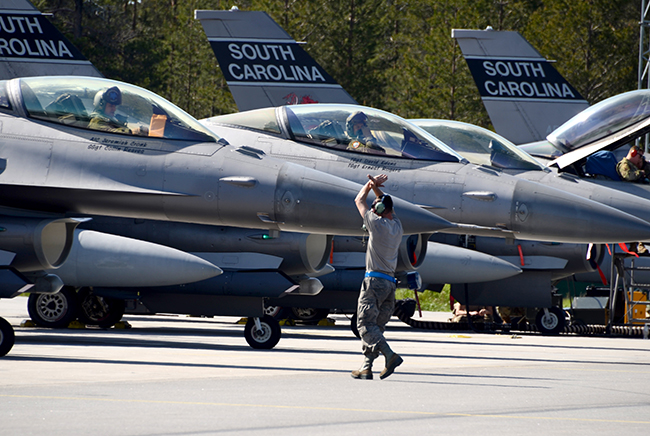
F-16s from the South Carolina Air National Guard, shown here during a recent exercise in Sweden, are part of US Southern Command's effort to bolster relations with Colombia as American adversaries reach out to nations in the region. Air National Guard photo by Capt. Rebecca Roodhouse.
US Southern Command chief Adm. Craig Faller this week argued for daily US presence in his region to push back against Chinese, Russian, and Iranian influence, saying American military operations need to continue alongside efforts to train local troops.
At a July 9 Senate Armed Services emerging threats and capabilities subcommittee hearing, Faller pointed to recent collaboration between the South Carolina National Guard and the Colombian military as an example of enduring partnerships that can strengthen the Southern Hemisphere.
“Our strategic bomber force and F-16 fighter aircraft from the South Carolina Air National Guard are training with the very capable Colombian Air Force,” Faller said. “This mission takes place in conjunction with the 100th anniversary of Colombia’s air force and builds interoperability and readiness in the face of regional and global challenges.”
In May, the South Carolina National Guard said it planned to participate in two large events in Colombia this summer, including sending four F-16s to an air show in Rionegro. Finance Colombia reported a B-52 bomber would also fly over the F-AIR Colombia air show this week. The state’s adjutant general and the commander of the South Carolina ANG’s 169th Fighter Wing also met with the Colombian defense chief and local Army and Air Force leaders this spring.
Partner nations in the SOUTHCOM region are asking to bolster their military relationships with the US as China tries to sweeten new partnerships with perks like Spanish-language training in Beijing, Faller said. Along with Colombia, he noted the Pentagon is also beefing up outreach to Brazil to ward off America’s adversaries.
“It’s up to us to deliver [training equipment and exercises] in a way that’s relevant, and also provides a return on investment for American taxpayers,” Faller said. “It begins with intelligence-sharing and education, frankly, at a person-to-person level and a mil-to-mil level. We enhance each other’s situational awareness, strengthen our understanding of the opportunities and challenges, and work on education, both in their schools and in ours.”
Maintaining other countries’ willingness to stick with the US instead of turning to foreign militaries is the right path forward, and Congress should fund more seats for foreign service members at American military schools, Faller added. He said SOUTHCOM could grow its share of that spending—which he said sits around $100 million across the Defense Department—from $11 million to $18 million, and see an outsized return on investment.
Faller also noted the Navy plans to provide a Littoral Combat Ship to the command in October to boost regional seapower and said more intelligence, surveillance, and reconnaissance assets would help to monitor the unrest in Venezuela as well as global counternarcotics operations.
